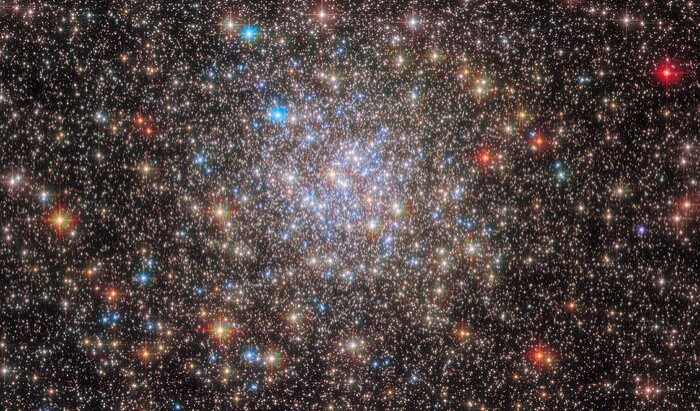NASA's Hubble Space Telescope gazes into the glittering chaos of the globular cluster NGC 6355. This starry spectacle hails less than 50,000 light-years away from our planet in the Ophiuchus constellation.
According to the European Space Agency (ESA), NGC 6355 is a galactic globular cluster that lies in the Milky Way's galaxy's inner areas.

Dense Collection of Stars
"A dense collection of stars covers the view. Towards the centre the stars become even more dense in a circular region, and also more blue. Around the edges there are some redder foreground stars, and many small stars in the background," ESA wrote in the image's description.
Globular clusters are tens of thousands to millions of star clusters that are stable and securely connected, and they can be found in all different kinds of galaxies.
These clusters are generally spherical in shape, with a bright concentration of stars in the center and an increasingly sparse sprinkling of stars around it, thanks to their dense stellar populations and gravitational attraction to one another.
The crowded region of stars toward the center of this image is the dense, bright core of NGC 6355, which Hubble was able to capture in great detail.
Hubble has revolutionized the study of globular clusters due to its vantage point above the atmosphere. With ground-based telescopes, it is nearly hard to separate the stars in globular clusters from one another, but Hubble has allowed astronomers to analyze the stars that make up globular clusters thoroughly.
Data from the Wide Field Camera 3 and Advanced Camera for Surveys are combined to create this Hubble image of NGC 6355.
The image makes vivid distinctions between the NGC 6355's central red and blue stars, showcasing the incredible observational ability of Hubble, which has transformed the study of globular clusters.
A Wealth of Globular Clusters
The vast knowledge of the astronomy community about these massive clusters can be attributed to the iconic telescope's wealth of globular cluster images.
Hubble made the first direct observations of white dwarfs in globular star clusters in 2006. White dwarfs are feeble remnants of stars that are created inside globular clusters when stars with masses equivalent to our sun lack fusion fuel and experience gravitational collapse, according to Space.com.
Hubble continues to capture globular clusters to enrich astronomers' understanding of the formation and evolution of stars.
If you want to see more snapshots of these clusters, you can view them through ESA's website.
Related Article : NASA's Hubble Space Telescope Captures 'Butterfly Nebula' In Stunning Motion | Fun Facts About This Beautiful Space Butterfly

ⓒ 2025 TECHTIMES.com All rights reserved. Do not reproduce without permission.




